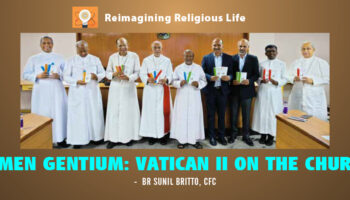“When someone comes to the door of the monastery, wishing to renounce the world and be added to the brothers, he shall not be free to enter. First, the father of the monastery shall be informed. He shall remain outside at the door a few days and be taught the Lord’s prayer and as many psalms as he can learn. Carefully shall he make himself known… If they see that he is ready for everything, then he shall be taught the rest of the monastic discipline.”
(Rule of Pachomius, 49)
Pachomius (290-346/47 CE) was the first person in the Christian tradition to offer a systematic Rule for religious life—a Rule which included instructions about whom to admit and the method of training a novice. The beginning of his spiritual itinerary was similar to Antony’s (Magnet, December 2017). After being baptized at the age of twenty-one, he was trained under a well-known hermit called Abba Palamon. Unlike Antony, who remained a hermit all his life, Pachomius set up monasteries in order to train novices by institutionalizing some stage of the solitary experience of hermits. His first experiment in the year 324 to have an organized community life was a failure. Though the experiment failed, he learnt that in order to successfully organize a religious community, the virtues of poverty and obedience were crucial; there could be no compromise on them. His second attempt would be successful. Within a few years more than 9000 monks would be living according to the Rule of Pachomius.
Pachomius was the first great organizer of religious life within the Christian tradition and the success of his organization centered around three activities—liturgy, work and the community meal. Though the Eucharist was the main celebration, the synaxis or regular common prayer would be an important feature of the Pachomian Rule. The synaxis consisted in readings from Scripture with a period of silent reflection and ended with the common recitation of the Our Father. The work that the monks engaged in was directly or indirectly related to agriculture and was conducted in groups. The community meal was an activity which led to collaboration among the monks and helped them grow into a close knit community. The daily routine of prayer, work and common meal nourished their inner life and helped them cultivate a life of virtue. Details of the manner in which community life was organized can be known by reading the three volumes of the Pachomian Koinonia, translated by Armand Veilleux (Cistercian Publications Inc., Michigan).
Though small communities existed, Pachomius gave organized religious life a totally new dimension. His genius lay in offering guidelines to help identify persons who were apt for religious life and then provide a framework within which such persons could be formed to live a life of service. Though religious life in common did not have the rigorous asceticism of hermitical life, it trained a monk towards a life of sharing. The dynamics of living together and rubbing shoulders with a variety of persons helped them grow in discipline, self-examination and discernment leading to greater inner freedom.
The death of Pachomius would provoke a minor crisis. However, the monks looked at the life of Pachomius for encouragement and fell back to the Rule as proposed by him to stabilize the situation.
As we look at religious life in today’s context, we see that the structure offered by Pachomius continues to be relevant. Many centuries have gone by and religious life has adapted itself to a variety of differing situations. Through all these vagaries of time, the core elements of the Pachomian Rule and the endearing personality of Pachomius continue to be an inspiration.

To subscribe to the magazine Contact Us





